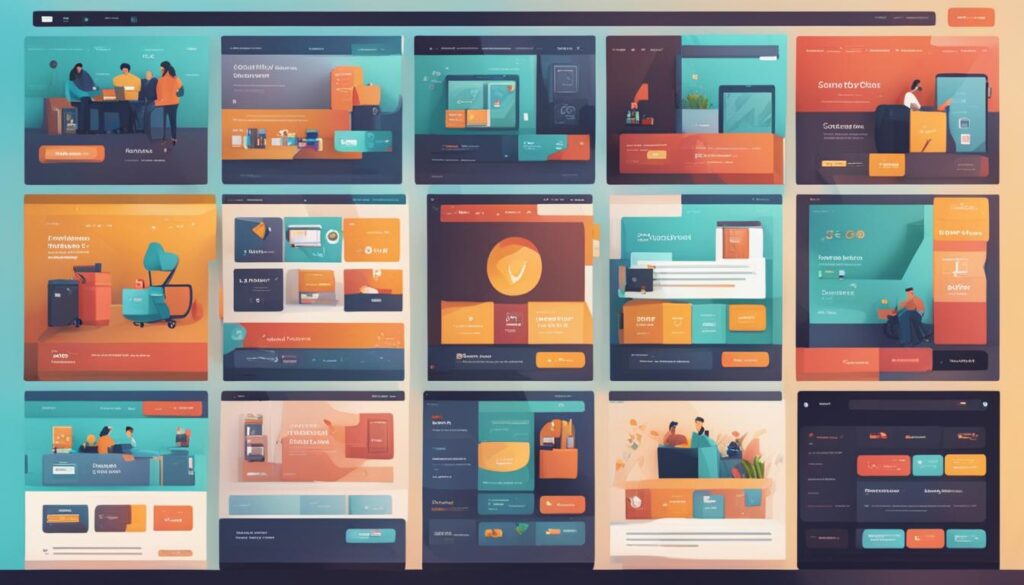We may earn money or products from the companies mentioned in this post.
Welcome to our guide to improving your e-commerce accessibility! In today’s digital age, online shopping has become increasingly popular, and creating an inclusive and accessible shopping experience is essential for businesses looking to reach a wider audience. This guide will provide you with valuable insights and practical tips for optimizing your e-commerce website’s accessibility, complying with ADA regulations, and creating a disability-friendly online store.
By implementing these strategies, you can improve your e-commerce accessibility and provide a seamless shopping experience for all users, regardless of their abilities.
Key Takeaways
- E-commerce accessibility is crucial for creating an inclusive and user-friendly online shopping experience.
- Complying with ADA regulations is essential for online businesses, and failure to do so can result in legal consequences.
- WCAG guidelines provide a framework for creating accessible online stores.
- Optimizing your website for accessibility can improve the user experience for all users, including those with disabilities.
- Considering assistive technology and usability testing can further enhance your e-commerce accessibility.
Understanding E-commerce Accessibility
E-commerce accessibility means creating an online shopping environment that is user-friendly and inclusive for all. It ensures that people with disabilities, including those with visual, auditory, cognitive, and physical impairments, can access and use your website with ease.
Web accessibility is not only important for people with disabilities; it also benefits businesses by widening their customer base, improving user experience, and increasing customer loyalty and satisfaction.
WCAG Guidelines for E-commerce
The Web Content Accessibility Guidelines (WCAG) provide standards and guidelines for making web content accessible to people with disabilities. In the context of e-commerce, WCAG guidelines help designers and developers create disability-friendly online stores that meet the needs of all users.
Some WCAG guidelines that are particularly relevant for e-commerce websites include:
- Providing alternative text for images and other non-text content
- Ensuring keyboard accessibility for all features and functionalities
- Designing clear and consistent navigation menus
- Using headings, lists, and other formatting features to improve content structure and readability
- Implementing responsive design to ensure compatibility with different devices and screen sizes
Accessible Online Shopping
Accessible online shopping means designing a virtual storefront that accommodates users with various disabilities. To achieve this, designers and developers must consider every aspect of the user experience, from the visual design and layout to the content and functionality.
Here are some tips for making your e-commerce website more accessible:
- Use high-contrast color schemes and clear typography to improve readability
- Avoid using color alone to convey meaning, as it can be difficult for users with color vision deficiencies to understand
- Provide clear and concise descriptions for all products and services
- Ensure that all forms and input fields are properly labeled and easy to use
- Consider offering alternative formats, such as audio or video, for users who have difficulty with written content
Optimizing Your E-commerce Website for Accessibility
Designing an e-commerce website that is accessible to all users is essential for creating a positive user experience and fostering customer loyalty. By optimizing your website for accessibility, you can ensure that all customers, regardless of their abilities, can navigate your online store with ease.
Designing for an Accessible User Experience
The first step in optimizing your e-commerce website for accessibility is to design a user-friendly interface. This includes features such as clear and concise labeling, easy-to-use navigation menus, and well-defined call-to-action buttons. Use color palettes that are accessible to users with color blindness or low vision and avoid the use of flashing or rapidly moving content that may trigger seizures.
Another important consideration is the use of responsive design. This design approach optimizes your website for all devices, including desktop computers, tablets, and smartphones, ensuring that it is accessible to users with varying abilities and preferences.
Assistive Technology for Online Shopping
Assistive technology can be an important tool for improving accessibility on your e-commerce website. Screen readers, for example, can read out the content of a website to users who are visually impaired, while keyboard shortcuts can help those who have difficulty using a mouse or touch screen. To optimize your website for assistive technology, consider adding features such as keyboard navigation and alt-tag descriptions for images and videos.
ADA Compliance for E-commerce: Legal Considerations
Ensuring that your e-commerce website is accessible to people with disabilities is not only the right thing to do, it’s also the law. Under the Americans with Disabilities Act (ADA), businesses that operate online are required to provide equal access to their goods and services to those with disabilities, just as they would for non-disabled customers.
While the ADA was originally enacted in 1990, the Department of Justice (DOJ) did not issue specific regulations for website accessibility until 2010. Since then, the DOJ and various courts have consistently held that the ADA applies to websites and mobile apps that offer goods and services to the public.
Failure to comply with the ADA can lead to legal action, including private lawsuits and investigations by the Department of Justice. In some cases, non-compliant websites may be required to pay damages to individuals who were unable to access their goods or services, as well as make changes to their website to ensure future accessibility.
Understanding ADA Compliance Guidelines
So, what does it mean for an e-commerce website to be ADA compliant?
The WCAG (Web Content Accessibility Guidelines) are a set of recommendations for creating accessible websites. The DOJ has adopted the WCAG 2.0 guidelines as the standard for website accessibility under the ADA. These guidelines cover a wide range of accessibility issues, including:
- Alternative text for non-text content (such as images)
- Keyboard navigation for all website functions
- Captions and transcripts for multimedia content
- Clear and consistent headings and labeling
- Color contrast for legibility
Ensuring Your E-commerce Website is Disability-Friendly
Designing a disability-friendly e-commerce website requires a thoughtful and informed approach. Some of the steps you can take to optimize your website for accessibility include:
- Building your website with responsive design, which automatically adjusts to fit different screen sizes and devices
- Providing clear and consistent labeling and navigation
- Using high contrast colors and easily readable fonts
- Offering alternative text for non-text elements such as images and videos
- Ensuring compatibility with assistive technologies such as screen readers and voice recognition software
By taking these steps, you can improve the accessibility of your e-commerce website and help ensure that everyone has equal access to your products and services.
Conclusion
Overall, prioritizing e-commerce accessibility is essential for creating an inclusive and user-friendly online shopping experience. By ensuring accessibility, businesses can tap into a vast and diverse customer base and build brand loyalty.
In conclusion, we encourage all online businesses to take the necessary steps to optimize their website for accessibility. By following the guidelines set forth by the ADA and WCAG, businesses can create a more welcoming and inclusive environment for all users.
The Benefits of Accessible Online Shopping
Accessible online shopping has numerous benefits, including providing equal opportunities for people with disabilities to shop online, increasing customer satisfaction, and expanding the customer base. In fact, a recent study showed that businesses that prioritize accessibility experience a 20% increase in revenue.
Take Action for E-commerce Accessibility
If you are an online business owner, we urge you to take action for e-commerce accessibility. Start by assessing your website’s accessibility, using tools like WebAIM and WAVE. From there, prioritize optimization strategies to enhance the user experience for all shoppers. By doing so, you can create an accessible online shopping destination that is welcoming and inclusive for all.
Thank you for joining us in prioritizing e-commerce accessibility!
FAQ
What is e-commerce accessibility?
E-commerce accessibility refers to the practice of ensuring that online shopping platforms are inclusive and usable for all individuals, including those with disabilities. It involves making websites and digital content accessible to users who may have visual, hearing, cognitive, or motor impairments.
Why is e-commerce accessibility important?
E-commerce accessibility is important because it allows individuals with disabilities to fully participate in online shopping experiences. It promotes inclusivity, equal access, and enhances the overall user experience. Moreover, compliance with accessibility standards ensures legal compliance and reduces the risk of discrimination lawsuits.
What are WCAG guidelines for e-commerce?
WCAG (Web Content Accessibility Guidelines) provide a set of technical guidelines for creating accessible web content. For e-commerce websites, WCAG offers specific recommendations to ensure accessibility for users with disabilities. These guidelines cover aspects such as website structure, navigation, multimedia, color contrast, and more.
How can I optimize my e-commerce website for accessibility?
There are several ways to optimize your e-commerce website for accessibility. Some strategies include designing user-friendly interfaces, using clear and descriptive headings, providing alternative text for images, implementing keyboard navigation functionality, and testing your website with assistive technologies to ensure compatibility.
What are the ADA compliance requirements for e-commerce?
The Americans with Disabilities Act (ADA) requires that e-commerce websites be accessible to individuals with disabilities. This means that online businesses must ensure that their websites are compatible with assistive technologies, provide alternatives for non-text content, offer accessible forms and checkout processes, and comply with other accessibility standards outlined in the ADA.
What are the consequences of non-compliance with ADA accessibility standards?
Non-compliance with ADA accessibility standards can result in legal consequences, including potential lawsuits and monetary penalties. It can also harm your business reputation and exclude a significant portion of potential customers. Ensuring ADA compliance for your e-commerce website is crucial to avoid these negative outcomes.
Affiliate Disclosure: This post may contain affiliate links. If you purchase through our link, we may receive a small commission, but at no additional cost to you. For more information, please see our Disclosure statement.



